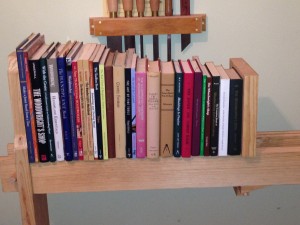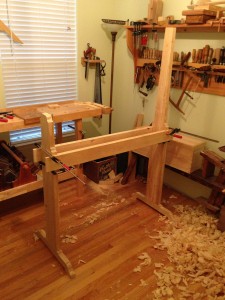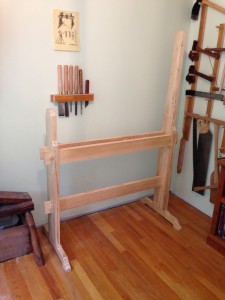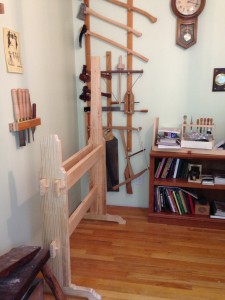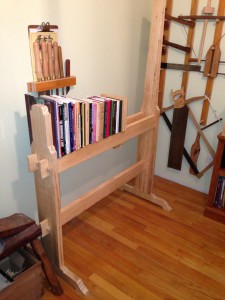 A few weeks ago, I posted some pictures of my spring pole lathe and the great progress I was making. Well, as always, life happens, and manages to alter the best laid plans of men. The lathe was to a point where it was looking really good. After chopping out the mortises, I noticed a bit of stiffness in my arm. I stopped working for the day and rested for the night. My arm was very swollen and I could not fully flex it. Where does the “Spring Pole Bookshelf” come in you may ask? Please bear with me and I will explain.
A few weeks ago, I posted some pictures of my spring pole lathe and the great progress I was making. Well, as always, life happens, and manages to alter the best laid plans of men. The lathe was to a point where it was looking really good. After chopping out the mortises, I noticed a bit of stiffness in my arm. I stopped working for the day and rested for the night. My arm was very swollen and I could not fully flex it. Where does the “Spring Pole Bookshelf” come in you may ask? Please bear with me and I will explain.
I rested my arm for a week, and took anti-inflammatories, and it was feeling better, although still a little swollen. Then, I made the mistake of using it again to install a storm door that was a Mother’s Day gift for my very patient wife. It re-injured my elbow so badly that I had to do the unthinkable; I had to cancel my Moravian Workbench class at Roy’s Woodwright’s School. I cannot tell you how disappointed I was when I realized I would not be able to physically stand up to a solid week of punishing mortise chopping, but I contacted Roy and let him know I was not going to be able to make the class.
Fast forward a couple of weeks to this past weekend, and after going to the Doctor and getting some stronger medication and a new arm brace, my injury was doing better. I decided to take it slow and do some limited work. I did some plane refurbishing, which amounted to some sanding of the sole of the plane and blade sharpening. I took frequent rests and iced my elbow after each session. I was not feeling any pain afterwards, and I could tell it was healing.
After doing some deep thinking about my predicament, I surmised that the root cause of the problem was the height of my workbench. I have not discussed my workbench a lot as it is a commercial bench I bought from Grizzly before I knew any better. It’s funny, for what I paid for this bench, I could have purchased the material for a really nice bench. I have made do with this light-weight, thin-topped, crappy-vised bench-shaped object for almost 3 years now, and I have never adjusted the height. That all changed. I reduced the height of my bench by 4 inches. I must tell you, this really made a huge difference. Planing is easier and so is sawing.
Now we get to the “Spring Pole Bookshelf” part: As I was piddling around the shop this weekend, I was cleaning, and I placed s few books on my lathe. They fit nicely on the bed and it got me thinkin’….If I cut a board the same shape as the tail stock, I could use it for a sliding bookend. This was just the small project I felt I could tackle with my limited elbow capacity.
I sawed out the block of wood and drilled a hole for a 1/2″ dowel rod and inserted the rod after placing the bookend on the lathe bed. I put my woodworking books on the lathe bed and adjusted the new bookend. I cut a wedge to set the bookend in place and it worked great; who needs a lathe when you have such a nice bookshelf! I took a few pics and then went to rest my arm and elbow on some ice.
I like this design concept and I will probably make a bookshelf similar to this after I complete the spring pole lathe. Yes, I plan to finish the lathe. This bookshelf was only a side-diversion to entertain me until I am physically able to continue the lathe project.
I will publish a list of my books in a later post. This is a combination of deliberate purchases, books I’ve had for years and lucky finds in the annual library book sale. All of the LAP or Lost Art Press books I own are definitely deliberate purchases.
One side note, I was planning on doing a “The Onion“-esque post with a title like “Traditional Woodworker Injures Self in Freak Strain-Related Accident” but decided I’m not the professional humorist like those that populate “The Onion.”
-Aaron

